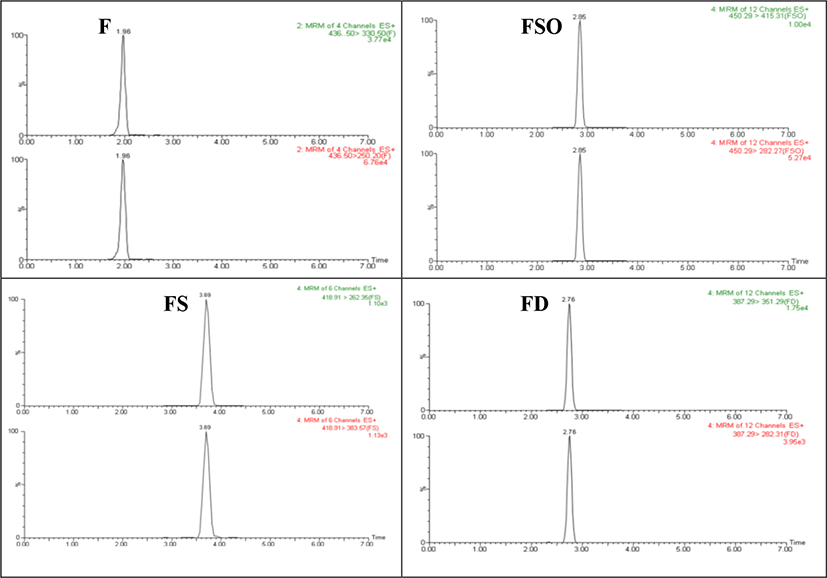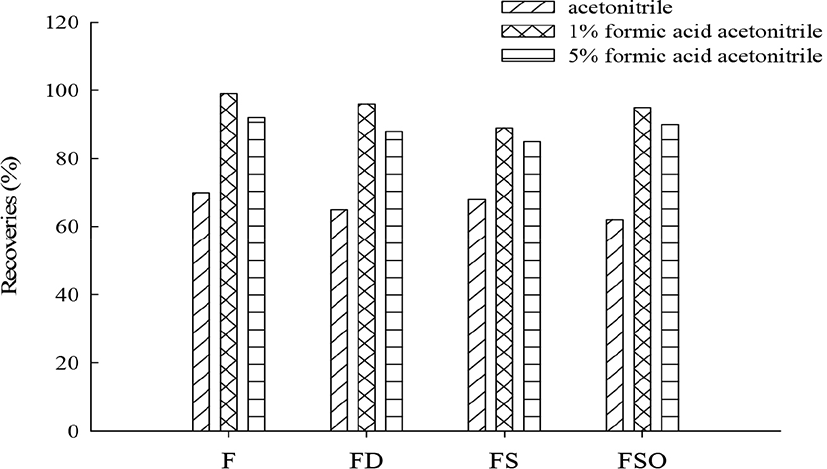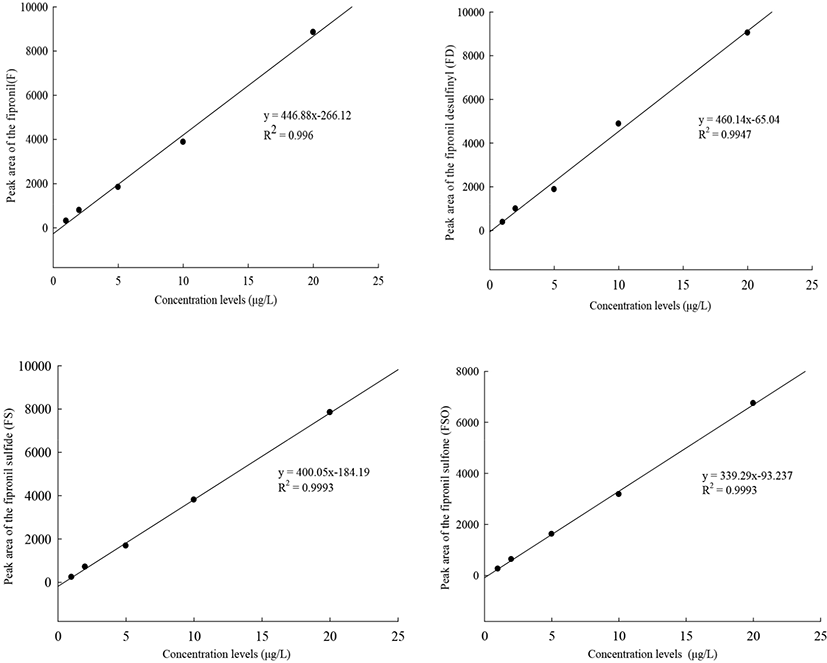Introduction
Eggs tainted with fipronil (F) were firstly reported in Belgium in 2017, then in the European Union, Korea, Hong Kong and Taiwan of China (Erickson, 2017). Soon afterwards chicken meat was also unveiled contaminated with fipronil (Stefanka et al., 2017). Fipronil is a kind of broad-spectrum insecticide of phenylpyrazole group sprayed in poultry house to prevent and treat ectoparasite infestation (Cochran et al., 2015), leading to its bioaccumulation in eggs. Additionally, misuse or abuse of fipronil can also cause fipronil residue in eggs. Long-term low-dose or short-time high-dose intake of egg-born fipronil and its metabolites can put liver, thyroid, kidney and nervous system under health risks (Kitulagodage et al., 2011; Simon-Delso et al., 2015). The maximum residue limit (MRL) of fipronil and its metabolites in vegetables, fruits, grain, and oil have been stipulated in many related food standards and regulations. The MRL of fipronil and its metabolites in eggs stipulated by the Codex Alimentarius Commission (CAC) is 20 μg/kg, the European Union 5 μg/kg, the USA 30 μg/kg, while it hasn’t been set in China.
Nowadays, various analytical methods have been introduced to determine fipronil and its metabolites in diverse matrices such as fruits (Duhan et al., 2015), vegetables (Kaur et al., 2015), peanut, soil et al. (Li et al., 2015), including gas chromatography (GC) (Guo et al., 2008), GC in tandem with mass spectrometry (GC-MS/MS) (Liu et al., 2019; Ramasubramanian et al., 2014), high performance liquid chromatography (HPLC) (Liu et al., 2008; Neagu et al., 2015), and liquid chromatography in tandem with mass spectrometry (LC-MS/MS) (Raju et al., 2016). Besides, QuEChERS-based method was also applied to determine fipronil in many matrices including eggs (Sack, et al., 2011; Xia et al., 2010), and it was popularized worldwide and proved effective, sensitive and accurate (Aruna et al., 2015; Yu et al., 2015).
The method of single-step, cheap, effective, rugged, safe-based method (SinChERS) is characterized by single-step, cheap, effective, rugged and safe. The validation parameters are based on the standards of AOAC Official Method 2007.01 and EN15662. It is a novel and proprietary way for sample preparation developed by the Anybond Technologies, Tianjin, China. QuEChERS was invented in 2003 by American chemists and widely used as a sample preparation technology in pesticides residue detection. Multi-wall carbon nanotubes (MWCNTs) was used in SinChERS to absorb different interfering co-extracts, while QuEChERS use primary secondary amine (PSA). Compared with PSA, MWCNTs have larger specific surface area and widely distributed mesopores and micropores in structure and thus exhibited excellent adsorption ability than PSA.
Animal-derived food matrix is so chemically complicated that sample preparation is extremely important for trace analysis, during which how to avoid the interference caused by co-extraction of non-target substances is the biggest challenge and hurdle. Sample preparation always accounts for 2/3 time of the whole process of analysis, directly impacting the efficiency and the accuracy of the quantification analysis and the instrument performance. The better method for sample treatment, the higher efficiency and precision of trace analysis.
Different from QuEChERS, SinChERS integrates extraction and purification steps into one single operation, avoiding loss of the target analyte during solvent transferring. In this one-step operation, only 5 mL extraction solvent was consumed for 10 g egg matrix and purification effect was good enough for later ultra high performance liquid chromatography coupled with mass spectrometry (UHPLC-MS/MS) analysis. It possess a higher recovery rate than QuEChERS and dispersive solid phase extraction (d-SPE).
In this study, SinChERS was applied for sample preparation and comparisons were made to QuEChERS and d-SPE in terms of time needed, solvent volume consumed, recovery rate and matrix effect (%ME) in the determination of fipronil and its metabolites fipronil desulfinyl (FD), fipronil sulfide (FS) and fipronil sulfone (FSO) by UHPLC-MS.
Materials and Methods
Standard reagents of F, FD, FS, and FSO (HPLC-grade, ≥99%) were supplied by Dr. Ehrenstorfer (Augsburg, Germany). HPLC-grade solvents ammonium acetate, methyl alcohol, formic acid and acetonitrile were procured from Fisher Scientific (Fair Lawn, NJ, USA). Anhydrous magnesium sulfate (MgSO4) of analytical-grade was the product of Agela Technologies (Tianjin, China). Water was collected from a Milli Q purification system (Millipore, Molsheim, France).
Waters Oasis HLB Solid phase extraction (SPE) purification column (6 mL/500 mg) was provided by the Troody Analytical Instrument (Shanghai, China). Supelco Envi-Carb/LC-NH2 purification column (6 mL/500 mg) was purchased from the Kanglin Instrument (Beingjing, China). QuEChERS purification column was from Sepax Technologies (Guangzhou, China). SinChERS purification column was the product of Anybond Technologies (Tianjin, China, http://www.anybond.com.cn/SinCHERS2), and was filled with 900 mg Na2SO4, 150 mg MWCNTs, and 150 mg C18.
The UHPLC-MS/MS system consists of a Waters UPLC system (USA), a Quattro Premier XE quadrupole mass spectrometer (The Science of Waters, USA), and a electrospray ionization (ESI) interface source. Other instruments include ultrasonic instrument (KQ5200DE, Kun Shan Ultrasonic Instruments, China), advanced vortex mixer (EOFO945601, TALBOYS, USA) and bath-typed nitrogen evaporator (OA-SYS, Organomation Associates, USA).
Stock solutions of standards F, FD, FS, and FSO were prepared by dissolving each into acetonitrile to 1,000 mg/L, stored in dark vials at –18°C. Working standard solution was a mixture of 4 standards, 1 μg/mL each, diluted with acetonitrile. The calibration standards (1, 2, 5, 10, and 20 μg/L) were prepared by stepwise dilution of the above working solution of each analyte (1 μg/mL) with blank matrix solution.
The egg content was collected and homogenized as egg sample. Five gram of egg sample along with 10 mL 1% formic acid acetonitrile was added to a 50 mL centrifuge tube and blended for 3 minutes followed by 10 minute ultrasonic treatment. Then 2 g anhydrous MgSO4 was added and mixed thoroughly. After centrifuging at 4,000 r/min for 5 minutes, a SinChERS purification column was vertically placed into the centrifuge tube and manually pressed downwards to the tube bottom. With the movement of the purification column, organic phase of the sample entered into the reservoir tank of the column through the purification bed. Approximately 2 mL liquid in the reservoir tank was transferred into a new centrifuge tube and dried at 40°C in nitrogen and then dissolved into 1 mL mobile phase containing 65% 1 mM ammonium acetate, and finally filtered through a 0.22 μm syringe filter. The filtrate collected was the final sample ready for UHPLC-MS/MS analysis.
The injection volume was 10 μL. A Shim-pack GIST C18 column (50×2.1 mm, 2 μm, Shimadzu) was applied and the temperature was controlled at 40°C. The mobile phase was the mixture of 1 mM ammonium acetate (A) and methyl alcohol (B). The flow rate was set to 0.3 mL/min. Gradient elution programs were given in Table 1.
| A (%) | B (%) | Time (min) |
|---|---|---|
| 65 | 35 | 0 |
| 45 | 55 | 1.5 |
| 15 | 85 | 3.5 |
| 65 | 35 | 3.5 |
| 65 | 35 | 4.0 |
MS/MS analyses were conducted on a LCMS-8050 equipped with an ESI source. All analytes were scanned by triple quadrupole multiple reaction monitoring mode (MRM) of negative ionization. Temperatures of desolvation line (DL), heat block and interface were 250°C, 400°C and 300°C, individually. The flow rate of nebulizer gas (N2), heater gas (N2) and drying gas (N2) was 3 L/min, 10 L/min and 10 L/min, respectively. Argon (Ar) was used as the collision gas. Detailed parameters for MRM transitions were listed in Table 2 and MRM chromatograms of 4 standards were showed in Fig. 1.

%ME was defined by the following equation where A is the peak area of the standard solution dissolved in acetonitrile, B is the peak area of the standard solution dissolved in blank egg matrix (Choi et al., 2015). If ME% falls into the scope of –20 to 20, it indicates no ME; ME%<−20 indicates ion suppression; ME%>20 indicates a signal enhancement.
Results and Discussion
Fipronil is a weak-polar compound that can be easily dissolved into organic reagents (Jacob et al., 2015). Acetonitrile is a routine extracting solvent in precipitating protein and other conjugates (Li et al., 2016). Formic acid, together with acetonitrile, can improve the recovery rate of polar compounds and other impurities (Liu et al., 2014).
Organic-grade egg liquid (negative samples) spiked with 5.0 μg/L working standard solution was used to select the extraction solvent for SinChERS. Acetonitrile, 1% formic acid acetonitrile (acetonitrile+1% formic acid ) and 5% formic acid acetonitrile (acetonitrile+5% formic acid) were recommended by the SinChERS manufacture as extraction solvents. Recoveries for the 4 analytes extracted by the above three tested candidate solvents were compared. It can be seen from Fig. 2 that all the recoveries were acceptable, ranging from 60% to 100%, and 1% formic acid acetonitrile showed the highest recovery rate for 4 target analytes.

Egg liquid contains a lot of fat, protein and some fat-soluble impurities (Jain et al., 2017; Stoddard et al., 2017). Different cleanup methods for fipronil and its metabolites in egg matrix have been reported, including QuEChERS (Shi et al., 2017) and d-SPE (Guo et al., 2017; Zhang et al., 2016). The prescribed d-SPE columns in Chinese trade standard SN/T 4039-2014 and the Chinese national standard GB 23200.34-2016 were HLB and Envi-Carb-NH2. Therefore, the cleanup effect of SinChERS was compared to QuEChERS, HLB, and Envi-Carb-NH2 in this study in terms of recoveries, consumption of organic solvents and time needed, using matrix-matching external standard method in which 5.0 μg/L mixture of working standard solution was spiked into egg samples.
As shown in Table 3, different columns received acceptable recoveries from 69% to 100%. Generally, SinChERS>QuEChERS>HLB>Envi-Carb-NH2. SinChERS and QuEChERS consumed the least organic solvent (10 mL) and needed less time than two SPE columns, HLB and Envi-Carb-NH2. It’s obvious that SinChERS clean-up column was even more time-saving than QuEChERS. Therefore, by comparison, SinChERS was a solvent-economic and time-saving option to extract the target analytes out of the complicated, fatty egg matrix, obtaining the best purification effect and the highest recoveries.
In similar studies, although the methods proved to be sensitive and reliable, the sample treatment is complex. In these studies, extraction and purification were separated operations, before purification, fipronil and its metabolites need to be salted out at −20°C (Guo et al., 2018) or evaporated to dryness (Liu et al., 2019) and be dissolved again. SinChERS avoids these steps and the operation is simplified, only ultrasonication and centrifugation are needed, thus make it convenient and time-saving. This novel rapid single-step extraction and cleanup method was applied to analyze up to 47 representative pesticide residues in vegetable and sauce products coupled with LC-MS/MS and GC-MS/MS detection, with modified cartridge fitted with multi-walled carbon nanotubes (MWCNTs), along with PSA and salts (Song et al., 2019).
Ionization suppression/enhancement could be brought about by sample matrix, sample preparation procedure or ionization types, leading to enhanced or weakened analytical signals and thus affecting the sensitivity and the precision of quantification. ESI is more prone to incur such effects than atmospheric pressure chemical ionization, especially when other compounds are eluted together with the analyte of interest. Sample matrix is another principal factor especially in LC–MS/MS and usually exhibited ionization inhibiting effects on ESI.
Mean values of ME% were presented in Table 3. Except HLB column for FS extraction, all ME% values fell into the scope of –20 to 20, indicating egg matrix showed no effects on UHPLC-MS/MS signals when treated by these cleanup columns. By comparison, the ME of HLB column was the biggest followed by QuEChERS and SinChERS. Envi-Carb-NH2 achieved the smallest values since it consisted of SPE adsorbent of Supelclean Envi-Carb (superstratum) and LC-NH2 (substratum) (Wu et al., 2012). However, these two materials were quite more expensive than that of SinChERS or QuEChERS column. In overall, SinChERS was a suitable column for sample preparation for UHPLC-MS/MS in analyzing fipronil and its metabolites in complicated egg fluid.
The linearity of the selected SinChERS method was evaluated using matrix-matched calibrations by spiking mixed standard solutions into blank egg samples to a final concentration of 1, 2, 5, 10, and 20 μg/L. Coefficient of determination (R2) and linear equations were obtained from the calibration curves (Fig. 3) drawn by plotting the peak areas against the concentrations of F, FD, FS, and FSO. As shown in Fig. 3, the calibration curves of fipronil and its metabolites exhibited sufficient linearity with R2>0.9947, indicating that the proposed method could be applied for effective determination of trace pesticides in egg samples.

To obtain the analytical limits of this method, the limit of detection (LOD) and the limit of quantitation (LOQ) were determined using signal-to-noise ratios (S/N) at 3 and 10, respectively. In the experiments described here, LODs and LOQs of all target analytes were 0.3 μg/kg and 1 μg/kg, meeting the criterion of Chinese GB 27417-2017.
These were estimated by spiking the mixed standard solution to blank egg samples to the final level of 1 μg/kg, 10 μg/kg, and 20 μg/kg in 6 duplicates according to the Chinese GB 2763-2016, which stipulated the MRL in most foods as 20 μg/kg. Repeatability (intra-day precision) was assessed by recovery and precision was expressed as the relative standard deviations (RSDs).
As shown in Table 4, recoveries of F, FD, FS, and FSO were ranged from 89.00% to 104.40%. RSDs were 3.88%–6.03% at 1 μg/kg, 4.15%–5.54% at 10 μg/kg, and 2.22%–4.53% at 20 μg/kg. All these recovery and RSD values met the criteria of precision and accuracy. Thus the SinChERS, using 1% formic acid acetonitrile as extracting solvent, coupled with UHPLC-MS/MS was sensitive enough to detect and quantify part-per-billion level (ng/g or μg/kg) of pesticide residue in eggs, and it was suitable for multi-residue analysis of fipronil and its metabolites in eggs.
The SinChERS-based UHPLC-MS/MS method was applied to real sample surveys. Thirty batches of domestic eggs were re-analyzed. These eggs have earlier been quarantined for other residues and all values were under the corresponding MRLs. They were collected from different farms of Shanxi province of China at different times. The results showed that neither fipronil nor its metabolites were detected above their LOQs.
Conclusion
The SinChERS-based UHPLC-MS/MS method established in this study was sensitive for simultaneous analysis of fipronil and its metabolites in complicated egg matrix with high precision and reliability. The SinChERS, integrating sample extraction and clean-up steps into one, matching with 1% formic acid acetonitrile as extracting solvent, was faster, easier, more convenient, more solvent-economic and time-saving than HLB, Envi-Carb-NH2 and QuEChERS columns. This sample preparation procedure exhibited slight ME in later UHPLC-MS/MS analysis. In summary, the established method could play important roles in guaranteeing the safety of egg and egg products. Further studies needed to carry out to try the possibility of this method to analyze more other harmful residues simultaneously.













